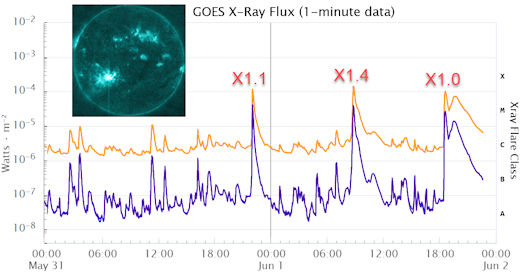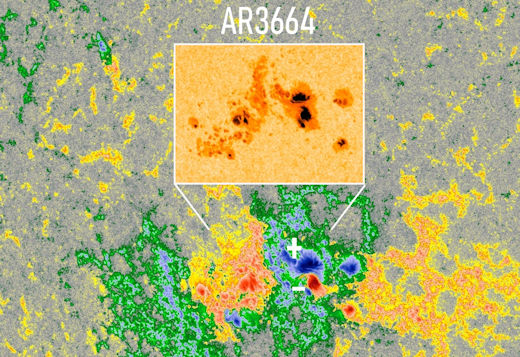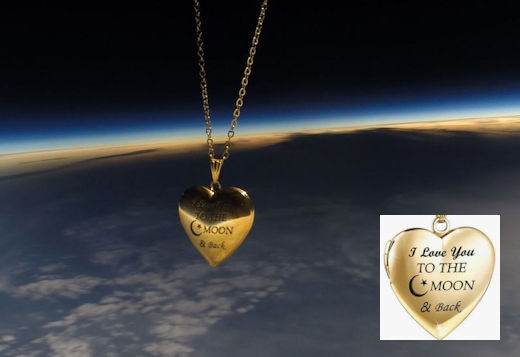 | | | Switch to: Europe, USA, New Zealand, Antarctica Credit: NOAA/Ovation  Planetary K-index Planetary K-index
Now: Kp= 1.33 quiet
24-hr max: Kp= 2.33 quiet
explanation | more data
Interplanetary Mag. Field
Btotal: 3.16 nT
Bz: 1.13 nT north
more data: ACE, DSCOVR
Updated: Today at 1147 UT  Coronal Holes: 01 Jun 24 Coronal Holes: 01 Jun 24 
There are no equatorial coronal holes on the Earthside of the sun. Credit: SDO/AIA  Polar Stratospheric Clouds
Colorful Type II polar stratospheric clouds (PSC) form when the temperature in the stratosphere drops to a staggeringly low -85C. NASA's MERRA-2 climate model predicts when the air up there is cold enough: 
On May 31, 2024, the Arctic stratosphere is much too warm for Type II polar stratospheric clouds. | more data. Noctilucent Clouds
The southern season for NLCs is over. The first clouds were detected inside the Antarctic Circle on Dec. 4, 2023, by the NOAA 21 satellite. The same satellite detected the last cloud on Feb. 21, 2024. Daily maps are now blank:

Updated: Feb 22, 2024
An instrument onboard NOAA 21 (OMPS LP) is able to detect NLCs (also known as "polar mesospheric clouds" or PMCs). Now that the southern season has ended, attention turns to the northern hemisphere. The first NLCs should appear inside the Arctic Circle in mid to late May.
 SPACE WEATHER
NOAA Forecasts | | Updated at: 2024 May 31 2200 UTC FLARE | 0-24 hr | 24-48 hr | CLASS M | 75 % | 75 % | CLASS X | 35 % | 35 % |  Geomagnetic Storms: Geomagnetic Storms:
Probabilities for significant disturbances in Earth's magnetic field are given for three activity levels: active, minor storm, severe storm Updated at: 2024 May 31 2200 UTC Mid-latitudes | 0-24 hr | 24-48 hr | ACTIVE | 30 % | 15 % | MINOR | 35 % | 05 % | SEVERE | 25 % | 01 % | High latitudes | 0-24 hr | 24-48 hr | ACTIVE | 05 % | 15 % | MINOR | 20 % | 25 % | SEVERE | 75 % | 25 % | | | |  | | | | | | | | | | | This is an AI Free Zone! Text created by Large Language Models is spreading rapidly across the Internet. It's well-written, artificial, frequently inaccurate. If you find a mistake on Spaceweather.com, rest assured it was made by a real human being. | | | GEOMAGNETIC STORM WATCH--CONTINUED: NOAA forecasters remain confident that a CME will graze Earth's magnetic field on June 1st. It was hurled into space by an X1.4-flare on May 29th. The glancing blow could cause G2-class geomagnetic storms. CME impact alerts: SMS Text X-FLARE AFTER X-FLARE AFTER X-FLARE: Exploding like popcorn, sunspot AR3664 (a.k.a. AR3697) produced three X-flares on May 31st and June 1st. The latest, a long-duration X1-class event, hurled a halo CME almost directly toward Earth. 
Official forecast models are not yet available for the incoming CME. SOHO coronagraph data are still too fragmentary. However, we can make a good guess for the ETA: June 4th. The impact could produce strong G3-class geomagnetic storms. Sunspot AR3664 has been decaying for days. What makes it so active? This magnetic map provides the answer: 
Within the sunspot's primary core, two oppositely-signed magnetic poles are crowded together, + vs. -. When this happens, magnetic recombination can cause very powerful explosions even from a sunspot that's falling apart. NOAA forecasters estimate a 35% chance of X-flares and a 75% chance of M-flares on June 1st. Solar flare alerts: SMS Text Realtime Space Weather Photo Gallery
Free: Spaceweather.com Newsletter
18K GOLD TOTAL ECLIPSE PENDANT: This pendant has touched the shadow of the Moon. On April 8, 2024, during a total eclipse of the sun in Texas, the students of Earth to Sky Calculus launched it to the stratosphere onboard a cosmic ray research balloon. Floating more than 118,110 feet high, the locket spent 3 minutes and 45 seconds wrapped in lunar shadow: 
You can have it for $199.95. The 18K gold-plated locket is inscribed with the words "I love you to the Moon and back," and opens to hold a personal photo or other small item. It comes with a greeting card showing the locket in flight and telling the story of its journey to the edge of space during the total eclipse.
Far Out Gifts: Earth to Sky Store
All sales support hands-on STEM education
Realtime Comet Photo Gallery
Free: Spaceweather.com Newsletter
Realtime Aurora Photo Gallery
Free: Spaceweather.com Newsletter
Every night, a network of NASA all-sky cameras scans the skies above the United States for meteoritic fireballs. Automated software maintained by NASA's Meteoroid Environment Office calculates their orbits, velocity, penetration depth in Earth's atmosphere and many other characteristics. Daily results are presented here on Spaceweather.com. On May 31, 2024, the network reported 11 fireballs.
(11 sporadics)  In this diagram of the inner solar system, all of the fireball orbits intersect at a single point--Earth. The orbits are color-coded by velocity, from slow (red) to fast (blue). [Larger image] [movies] Potentially Hazardous Asteroids ( PHAs) are space rocks larger than approximately 100m that can come closer to Earth than 0.05 AU. None of the known PHAs is on a collision course with our planet, although astronomers are finding new ones all the time. On June 1, 2024 there were 2349 potentially hazardous asteroids.
 | Recent & Upcoming Earth-asteroid encounters: | Asteroid | Date(UT) | Miss Distance | Velocity (km/s) | Diameter (m) | | 2024 JO16 | 2024-May-27 | 8 LD | 8.8 | 20 | | 2024 KS1 | 2024-May-27 | 6.4 LD | 12.4 | 14 | | 2008 LD | 2024-May-28 | 7.7 LD | 4.5 | 6 | | 2024 JV17 | 2024-May-28 | 17.3 LD | 8.4 | 43 | | 2021 LV | 2024-May-29 | 12 LD | 15.5 | 9 | | 2024 JG | 2024-May-29 | 8.7 LD | 7.4 | 32 | | 2024 KR | 2024-May-29 | 16.2 LD | 17.1 | 160 | | 2024 KP | 2024-May-29 | 2.1 LD | 12.2 | 24 | | 2024 KQ | 2024-May-29 | 9.8 LD | 8.3 | 24 | | 2024 KU | 2024-May-29 | 1.6 LD | 9.4 | 8 | | 2024 JA3 | 2024-May-30 | 6.2 LD | 8.5 | 36 | | 2024 KY | 2024-May-30 | 3.7 LD | 7.2 | 20 | | 2024 KX | 2024-May-31 | 0.8 LD | 8.3 | 11 | | 2008 XH | 2024-May-31 | 13.8 LD | 14.7 | 102 | | 2024 KB1 | 2024-Jun-01 | 1 LD | 11.1 | 8 | | 2024 JP1 | 2024-Jun-01 | 18.5 LD | 4.7 | 25 | | 2024 JC1 | 2024-Jun-01 | 15.1 LD | 4.8 | 34 | | 2024 KO1 | 2024-Jun-01 | 7.2 LD | 7 | 14 | | 1998 KY26 | 2024-Jun-01 | 12 LD | 5.3 | 25 | | 2016 JC6 | 2024-Jun-01 | 19.9 LD | 7.1 | 188 | | 2024 KZ | 2024-Jun-03 | 11.5 LD | 9.9 | 37 | | 2024 KT1 | 2024-Jun-03 | 4.8 LD | 7.2 | 14 | | 2024 KK1 | 2024-Jun-04 | 11.2 LD | 4.6 | 21 | | 2024 JR17 | 2024-Jun-05 | 19.3 LD | 14.5 | 85 | | 2008 YN2 | 2024-Jun-05 | 10.5 LD | 7.7 | 20 | | 2021 LW3 | 2024-Jun-06 | 9.7 LD | 9.8 | 86 | | 2024 KA1 | 2024-Jun-07 | 4.9 LD | 8.3 | 31 | | 2024 CR9 | 2024-Jun-11 | 19.2 LD | 7.4 | 447 | | 2022 XC1 | 2024-Jun-12 | 16.5 LD | 6.5 | 21 | | 2022 WW11 | 2024-Jun-17 | 19.7 LD | 14.4 | 15 | | 2024 KN1 | 2024-Jun-23 | 14.7 LD | 4.6 | 28 | | 2024 KJ | 2024-Jun-25 | 13.7 LD | 4.5 | 25 | | 2019 NJ | 2024-Jun-27 | 17.2 LD | 10.1 | 66 | | 415029 | 2024-Jun-27 | 17.3 LD | 25.9 | 2304 | | 2022 MM1 | 2024-Jun-28 | 7.8 LD | 10.9 | 39 | | 2010 XN | 2024-Jun-28 | 14.1 LD | 11.3 | 52 | | 2022 HD1 | 2024-Jun-29 | 17.3 LD | 7.2 | 63 | | 2017 MB3 | 2024-Jun-30 | 5 LD | 6.5 | 30 | | 2024 JJ25 | 2024-Jun-30 | 10.5 LD | 9.3 | 118 | | 2022 BY39 | 2024-Jul-02 | 13.2 LD | 3 | 4 | | 2024 KQ1 | 2024-Jul-04 | 15.2 LD | 6.8 | 57 | | 2022 YS5 | 2024-Jul-11 | 11 LD | 5.8 | 38 | | 2024 BY15 | 2024-Jul-16 | 16.2 LD | 0.7 | 16 | | 2011 MW1 | 2024-Jul-25 | 10.1 LD | 8 | 120 | | 2011 AM24 | 2024-Jul-26 | 16.8 LD | 6.2 | 281 | | 523664 | 2024-Jul-28 | 14.9 LD | 23.7 | 680 | Notes: LD means "Lunar Distance." 1 LD = 384,401 km, the distance between Earth and the Moon. 1 LD also equals 0.00256 AU. | | Cosmic Rays in the Atmosphere | SPACE WEATHER BALLOON DATA: Almost once a week, Spaceweather.com and the students of Earth to Sky Calculus fly space weather balloons to the stratosphere over California. These balloons are equipped with sensors that detect secondary cosmic rays, a form of radiation from space that can penetrate all the way down to Earth's surface. Our monitoring program has been underway without interruption for 7 years, resulting in a unique dataset of in situ atmospheric measurements. Latest results (July 2022): Atmospheric radiation is decreasing in 2022. Our latest measurements in July 2022 registered a 6-year low: 
What's going on? Ironically, the radiation drop is caused by increasing solar activity. Solar Cycle 25 has roared to life faster than forecasters expected. The sun's strengthening and increasingly tangled magnetic field repels cosmic rays from deep space. In addition, solar coronal mass ejections (CMEs) sweep aside cosmic rays, causing sharp reductions called "Forbush Decreases." The two effects blend together to bring daily radiation levels down. .Who cares? Cosmic rays are a surprisingly "down to Earth" form of space weather. They can alter the chemistry of the atmosphere, trigger lightning, and penetrate commercial airplanes. According to a study from the Harvard T.H. Chan school of public health, crews of aircraft have higher rates of cancer than the general population. The researchers listed cosmic rays, irregular sleep habits, and chemical contaminants as leading risk factors. A number of controversial studies (#1, #2, #3, #4) go even further, linking cosmic rays with cardiac arrhythmias and sudden cardiac death. Technical notes: The radiation sensors onboard our helium balloons detect X-rays and gamma-rays in the energy range 10 keV to 20 MeV. These energies span the range of medical X-ray machines and airport security scanners. Data points in the graph labeled "Stratospheric Radiation" correspond to the peak of the Regener-Pfotzer maximum, which lies about 67,000 feet above central California. When cosmic rays crash into Earth's atmosphere, they produce a spray of secondary particles that is most intense at the entrance to the stratosphere. Physicists Eric Regener and Georg Pfotzer discovered the maximum using balloons in the 1930s and it is what we are measuring today. | | The official U.S. government space weather bureau | | | The first place to look for information about sundogs, pillars, rainbows and related phenomena. | | | Researchers call it a "Hubble for the sun." SDO is the most advanced solar observatory ever. | | | 3D views of the sun from NASA's Solar and Terrestrial Relations Observatory | | | Realtime and archival images of the Sun from SOHO. | | | information about sunspots based on the latest NOAA/USAF Active Region Summary | | | current counts of failed and deployed Starlink satellites from Jonathan's Space Page. See also, all satellite statistics. | | | Authoritative predictions of space junk and satellite re-entries | | | from the NOAA Space Environment Center | | | fun to read, but should be taken with a grain of salt! Forecasts looking ahead more than a few days are often wrong. | | | from the NOAA Space Environment Center | | | the underlying science of space weather |  | Got a chipped or cracked windshield that prevents you from seeing space weather events while driving? Get windshield replacement from SR Windows & Glass with free mobile auto glass service anywhere in the Phoenix area. |  | Marketing yourself on YouTube is hard without real organic views on your videos. You can buy organic YouTube views from and enjoy social boosting that is actually real. Highly recommended! |  | When looking for casinos to play online when the weather is bad, you can try the SkyCity Online Casino if you are located in New Zealand. If you are not from NZ you can try the Swedish page Svenska casino online to find suitable games, check out svenskacasinoonline.net. Always check your local laws before playing with real money.. |  | BestCSGOGambling is the best site for everything related to CSGO gambling on the web | | | These links help Spaceweather.com stay online. Thank you to our supporters! | | | | | | | | |  | |  |   | ©2021 Spaceweather.com. All rights reserved. This site is penned daily by Dr. Tony Phillips. | |

